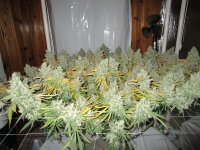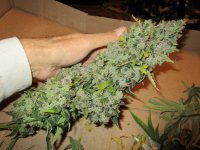CannaT
starin' at the world through my rearview
Im the worst for triming plants machine trim better than me.Hard time to see much difference, at least in sparkle. Surprising similar in morphology, not what i would expect.
In this case the led bud seems to sparkle more but i think thats down to the lighting, hid bud has lower and less direct light on it. Hid bud looks a bit fluffier and less dense.
Again hard to evaluate due to differences in lighting. The last one of the HPS pic does look great, i happily admitt bit not really a slam dunk case imo.
This one actually shows something re morphology: led bud looks denser and with a bit darker sugar leaves. This is quite usual in led buds, less infra red and heat usually leads to anthocyanin accumulation which many times lead black/purplish coloration
In general: there seems to a bit of difference in trim technique and how deep you trim. They seem a bit small, like the one from my failed crop. Trichomes look fairly similar in most cases. Best looking bud for trichome cover is the HID bud i mentioned specially.
Again, wheres the relevant argument? This is a thread about led bud quality, how to achieve it etc. If youre argument is that without HPS infrared theres no trichome coverage i cant really see that you shown a clear case. In my opinion if there ever was an argument for hps and quality it would be that even though it has minimal blue (usually ive seen quoted 6% rather than 10%) the little blue is spread out over a larger section of the spectrum. But sorry no sorry i dont really see that as a "gotcha, hps > led".
If you want help growing better with leds please hit me up over PM and ill help you out, its not difficult to setup a uv channel with continuous coverage of blues an uv. Or even a nice wide red sup for more volatiles. Stop sounding your voice just cause you cant get on board with the subject matter: how to grow better weed with leds. Im sure there are plenty of threads that have the subject of led vrs hps. If you read the paper i posted you could maybe begin to get an idea why HPS create quite good results aswell, though with more watts and heat. Did you ever grow in a really hot climate? Both lights have its advantages and disadvantages depending on climate. Nobody is making you grow with leds here. Hope it helps







